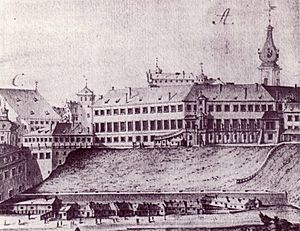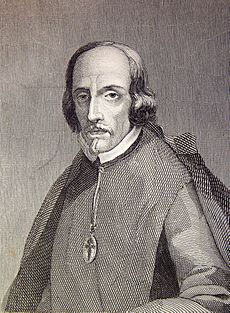Life Is a Dream facts for kids
Quick facts for kids Life Is a Dream |
|
|---|---|
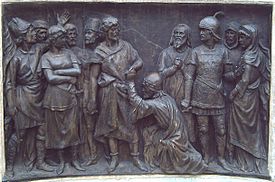
Detail from bronze relief on a monument to Calderón in Madrid, J. Figueras, 1878
|
|
| Written by | Pedro Calderón de la Barca |
| Date of premiere | 1635 |
| Original language | Spanish |
| Subject | Free will, fate, honor, power |
| Genre | Spanish Golden Age drama |
| Setting | Poland |
Life Is a Dream (Spanish: La vida es sueño) is a famous play written in Spanish by Pedro Calderón de la Barca. It was first published in 1636. Many experts believe the play was written around 1630. This makes it one of Calderón's most well-known early works.
The play is a deep story about what it means to be human and the mysteries of life. It is often called the best example of Spanish Golden Age drama. The story is about a fictional character named Segismundo, who is the Prince of Poland. His father, King Basilio, locks him away in a tower. This happens because a prophecy said Segismundo would bring disaster to the country and cause the King's death.
King Basilio lets Segismundo out for a short time. But when the prince causes trouble, the King puts him back in prison. He then convinces Segismundo that his time outside was just a dream. The play explores big ideas like whether we control our own lives (free will) or if everything is decided for us (fate). It also looks at how important honor is. Life Is a Dream is still one of Calderón's most studied plays. It was even named one of the 40 greatest plays ever by The Independent newspaper.
Contents
What Was Spain Like When the Play Was Written?
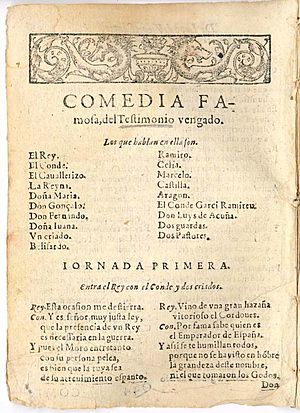
By the 1500s, Catholic Spain was one of the most powerful countries in Europe. However, Spain's power began to fade by the time Calderón wrote Life Is a Dream. The Spanish navy, called the Spanish Armada, was defeated by England in 1588. Also, the gold and silver from Spain's lands in the New World (like the Americas) were not enough to pay for its many wars.
During this time, Spain was also very religious. The Catholic Church played a huge role in Spanish identity. People even said "speaking Christian" to mean speaking Spanish. This period, from the 1500s to the 1600s, was known as the Spanish Golden Age. It was a time when Spain created many famous works of art and literature. For example, Don Quixote by Miguel de Cervantes (1605) explored the blurry line between what is real and what is imagined. Lope de Vega's play Fuente Ovejuna (1619) was about a village that stood up against unfair rulers.
What Happens in the Play?
Act I: The Prince in the Tower
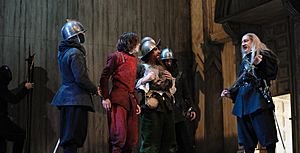
The play begins with Rosaura, dressed as a man, and her servant Clarín. They are lost in the mountains of Poland after their horses run away. They discover a hidden tower. Inside, they find Segismundo, who is chained up. He tells them his only crime was being born.
Clotaldo, who is Segismundo's old guard and teacher, arrives. He orders his soldiers to kill the strangers. But Clotaldo sees that Rosaura carries a sword that he recognizes. It was a sword he left behind years ago for his child. He suspects Rosaura might be his child (he thinks she is a boy). So, he takes Rosaura and Clarín to the royal court.
At the palace, Duke Astolfo and Princess Estrella are talking. They are cousins and the nephew and niece of King Basilio of Poland. They discuss that if they marry, they would become the next king and queen. Estrella is bothered by a locket Astolfo wears, which has another woman's picture inside.
King Basilio then tells them a big secret. He explains that he locked up his baby son, Segismundo, because a prophecy said the prince would bring shame to Poland and kill his father. But the King wants to give his son a chance to prove the prophecy wrong. If Segismundo is still bad, he will be sent back to his cell. Then Astolfo and Estrella would become the new rulers. Clotaldo arrives with Rosaura and Clarín. He tells the King that the strangers know about Segismundo. The King forgives Clotaldo, saying the secret is already out. Rosaura tells Clotaldo she wants revenge against Astolfo, but she doesn't say why. Clotaldo doesn't want to admit he thinks he is Rosaura's father.
Act II: A Prince's Wild Dream
Clotaldo gives Segismundo a sleeping potion. This makes him fall into a deep sleep, almost like death. At the Royal Palace in Warsaw, Clotaldo learns that Rosaura is actually a woman. Clarín explains that Rosaura is now Princess Estrella's maid, using the name Astrea.
When Segismundo wakes up, he is at the royal court. Clotaldo tells him he is the Prince of Poland and the rightful heir to the throne. Segismundo is angry that Clotaldo kept this secret from him for so long. He finds Duke Astolfo annoying and is amazed by Estrella's beauty. When a servant warns him that Estrella is engaged to Astolfo, Segismundo gets so mad that he throws the servant from a balcony.
The King demands an explanation from his son. He tries to calm Segismundo, but the prince declares he will fight everyone for his rights. King Basilio warns him to behave, or he might find out he's dreaming. Segismundo interrupts a conversation between Rosaura and Clarín. Clotaldo steps in to protect Rosaura. Segismundo pulls out a dagger, threatening to kill Clotaldo. As Clotaldo begs for his life, Astolfo challenges Segismundo to a duel. Before they can fight, the King gives Segismundo another sleeping potion and sends him back to his cell.
|
Segismundo's thoughts The king dreams he is a king, |
Estrella tells Rosaura (still called Astrea) to get the locket from Astolfo. When Rosaura asks Astolfo for it, he recognizes her as Rosaura. He refuses to give her the locket because it holds her own portrait. Estrella walks in and demands to see it. Afraid of being found out, Rosaura says the locket is hers and Astolfo has hidden the one she was sent to get. Estrella leaves, very angry. Meanwhile, Clotaldo sends Clarín to prison, thinking Clarín knows his secret.
Segismundo talks in his sleep about fighting and revenge. When he wakes up, he tells Clotaldo about his "dream." Clotaldo tells him that even in dreams, people should act with kindness and fairness. After Clotaldo leaves, Segismundo thinks deeply about dreams and life.
Act III: The Prince's Choice
The people of Poland find out they have a prince. Many of them rebel and break Segismundo out of his prison tower. At first, they mistakenly think Clarín is the prince, which is quite funny. Segismundo finds Clotaldo, who is scared of what Segismundo will do. But Segismundo forgives him and asks Clotaldo to join his side. Clotaldo refuses, saying he must stay loyal to the King.
Back at the palace, everyone gets ready for battle. Clotaldo talks with Rosaura. She asks him to kill Astolfo, who had dishonored her. Clotaldo refuses, reminding her that Astolfo is now the heir to the throne. When Rosaura asks about her honor, Clotaldo suggests she go to a nunnery. Upset, Rosaura runs away.
Rosaura finds Segismundo. She tells him her story: she was born in Muscovy to a noble woman who was disgraced. Rosaura faced the same fate, falling in love with Astolfo, who then left her to marry Estrella. She followed him to Poland for revenge. She found out Clotaldo is her father, but he won't fight for her honor. Rosaura compares herself to the female warriors Athena and Diana. She wants to join Segismundo's battle and either kill Astolfo or die fighting. Segismundo agrees. Soldiers cheer for Segismundo. Rosaura and Clarín are reunited. The King's soldiers approach.
Segismundo's army starts winning the battle. Basilio, Clotaldo, and Astolfo prepare to escape. Clarín is killed right in front of them. Segismundo arrives, and King Basilio faces his son, expecting to die. But Segismundo spares his father's life. Because of the Prince's kind actions, the King declares Segismundo the heir to his throne.
As king, Segismundo decides that Astolfo must marry Rosaura to restore her honor. At first, Astolfo doesn't want to because she is not of noble birth. But when Clotaldo reveals that Rosaura is his daughter, Astolfo agrees. Segismundo then decides to marry Estrella himself. Segismundo promises to live by the idea that "God is God." He understands that whether he is awake or dreaming, he must always try to do good.
Big Ideas in the Play
Is Life a Dream or Reality?
The idea that life might be a dream is very old. It can be found in ancient philosophies like Hinduism and Greek philosophy. For example, Plato's famous Allegory of the Cave explores this idea. This concept is also linked to René Descartes' dream argument, which questions how we know if we are awake or dreaming. Many writers, from Lope de Vega to Shakespeare, have explored this theme.
Father vs. Son Conflict
A main conflict in the play is between the king and the prince. This is like the struggles between gods in old myths, such as Uranus versus Saturn. This kind of conflict between a father figure and a son is common in plays from the Baroque period.
The Importance of Honor
The idea of honor is very important for the character Rosaura. She feels that her honor has been taken away, and her main goal is to get it back. Rosaura believes that she and her mother faced the same unfair situation. She asks Clotaldo to help her get her honor back, but he refuses and suggests she go to a nunnery instead.
Other Ideas and Symbols
The play also includes other interesting ideas and symbols. These include the labyrinth (a maze), the idea of a monster, the debate between free will (making your own choices) and predestination (everything is already decided), the four elements (earth, air, fire, water), and the ideas of original sin, pride, and disappointment.
Other Versions of the Play
On Stage
- A Dutch version, Het Leven is maer Droom, was performed in Brussels in 1647.
- Helen Edmundson's version of Life Is a Dream was shown at the Donmar Warehouse in 2009. It starred BAFTA Award-winner Dominic West.
- Rosaura, a 2016 version by Paula Rodríguez and Sandra Arpa, focuses on Rosaura. It shows how she fights against her difficult life and the rules placed upon her.
- Calderón’s Two Dreams was performed by the Magis Theatre Company in 2017. It included a new translation of Life is a Dream.
As an Opera
- Life Is a Dream is an opera by Jonathan Dove (composer) and Alasdair Middleton (writer). It was first performed by Birmingham Opera Company in 2012.
- Another opera, Life Is a Dream, by Lewis Spratlan (composer) and James Maraniss (writer), premiered at the Santa Fe Opera in 2010.
In Other Media
- Popular Song: Some lines from Act 2 of the play are used in the Jumpstyle song "Que es la Vida" by Martillo Vago.
- Film: Raúl Ruiz's 1987 film Life is a dream is partly based on the play.
- Song: The title song of the progressive metal band Haken's album Visions uses an English translation of a part of the play.
See also
 In Spanish: La vida es sueño para niños
In Spanish: La vida es sueño para niños
- List of Calderón's plays in English translation


